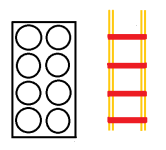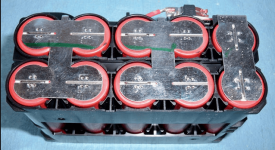I haven't had a chance to experiment with spot-welding copper strips onto cells, but I have some advice to help increase your chances of success.
I would start with attempting to connect two parallel strips onto the cell-tip, and the two strips must be electrically isolated from each other. You may have noticed on the common nickel strips, that there is a short slit right over the place where the ribbon connects to the cell. Because the nickel ribbon is conductive, and the cell tip is also conductive...the spot-welding jolt will take the path of least resistance. The cell ends are typically nickel-plated steel, so the conductivity of the bus-ribbon and the cell tip is about the same for both (common nickel has a conductivity that is IACS 22/100 of pure copper).
Although nickel is a conductor, its conductivity is so low that in some applications, it is used as a resistor. For instance, many simple and robust heating elements use a coil of NiChrome wire (Nickel / Chrome) to convert current to heat. Nickel continues to be used by industry for several reasons, one of which is its resistance to corrosion, and also the fact that it can easily be spot-welded by robots.
For low-amp battery packs in laptop computers, nickels' resistance is not an issue. But for high-amp battery packs in cordless tools, that industry has migrated over to using nickel-plated copper. A thin plating of nickel provides corrosion resistance and also makes spot-welding (again, by robots) remaining as a viable assembly method. This nickel plating is so thin, it does not cause a huge voltage drop, and any heat that is generated in 'normal use' is quickly absorbed by the mass of copper and then dissipated evenly, without causing localized hot spots in the bus.
Brass has a conductivity of 28/100 of copper, so its roughly 20% better than nickel, but still resistive enough that it should spot-weld easily, so its an option that might be worth trying out. However, spot-welding pure copper to the cell tips remains a useful idea. When considering copper, if you use a solid single ribbon with no slits (to mimic the common nickel ribbon that comes in a roll)...I am certain the majority of the jolt will flow across the ribbon from one electrode to the other...with very little passing across the cell-tip.
You must force the jolt to pass across the cell-tip so that the cells nickel-plating gets hot enough to melt onto the copper ribbon.





